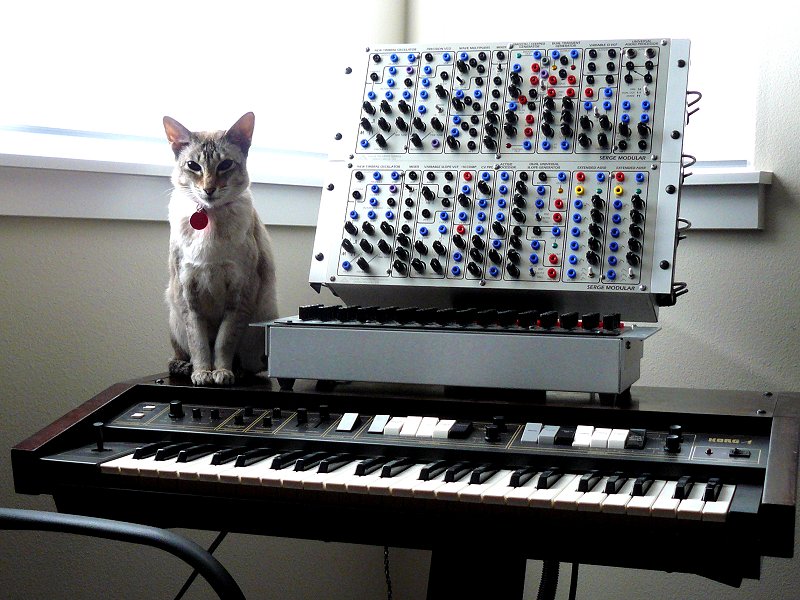

Serge-flavored modular synthesis provides the
musician/programmer with an absolutely blank canvas and a huge rainbow palette of colors
as opposed to the limited hues of a hardwired synth or even many other modulars. A lot of people seem to
use the Serge solely for ambient
and experimental music but, maybe because I use a standard keyboard controller, I have found the Serge equally up to
the task of more "normal" or, at least, equal-tempered types of music.
Patching on the Serge is done with bananna jacks, obviating the need for multiples since banannas are stackable and, electrically, the connections are more robust.
The Serge is kind of hard to nail-down and quantify because, depending on how they're patched, some modules
can be many different things - this is called "patch programmable" in serge-speak. Most notable in this regard is the Dual Universal Slope Generator, it can be any of the following things:
Non-linear lowpass filter
Envelope follower
Sub-harmonic generator
Linear portamento
Exponential portamento
Programmable pulse divider
Linear AR envelope generator
Exponential AR envelope generator
Linear ASR envelope generator
Exponential ASR envelope generator
Voltage controlled triangular LFO with adjustable angles
Voltage controlled variable pulse LFO
1 Volt-per-octave Audio VCO
Semi-random voltage generator
Semi-random pulse generator
...the list goes on.
Two other modules with a huge ammount of multiple functionality are the Dual Transient Generator, a cut-down version of the DSG, and the Smooth/Stepped Generator, a weird Sample and Hold / Track and Hold / Slew Generator hybrid.
The different Serge filters are interesting too in that usually multiple responses are available simultaneously LP, HP BP Notch...etc. My favorite Serge Filter, the Variable Slope VCF has a voltage controllable respomse slope from about 6Db/Oct to around 24Db/Oct for unique realtime changes in timbre. The "regular" Multimode Filter, the Variable Q VCF, is unique in that it can be "rung" with a trigger for dampened sine waves, plus it also has a low frequency mode used for processing CVs. There is also a multiple bandpass filter with CV variable width for realtime formant manipulation...there are many fun possibilities not normally available on other systems.
There are some hard to describe oddball modules that are pretty cool as well like the Wave Multipliers module, made up from 3 sub-modules:
1) The upper section can operate two ways. With the switch in the HI position this module will "square up" an incoming signal, similar to a comparator but more like the soft clipping you might get from an old tube amp. Put a sinewave through here, apply a CV and you have a variable pulse waveform. With the switch in the LO position, it becomes a VCA useful for amplitude modulation and gating.
2) The middle section is unique. It provides a voltage-controllable sweep of odd harmonics in a signal. If you put a sinewave through the input, you can get weird "overblown" wind instrument type timbres. This section is reminiscent of a ring modulator when used on more complex waveforms but much stranger sounding!
3) The bottom section is 3 full-wave rectifiers in series - fully voltage controllable. You can really dirty up the sound with this thing.
No other system has quite these kind of re-configurable modules though there is some kindred functionality in the Buchla and Modcan camps. This kind of flexibility means more powerful sound design and an amazing ammount of power in a small space. This is one of
the main reasons the Serge is such a unique and dynamic synthesis system!
The Serge, like most modulars, is monophonic unless you have enough panels/oscillators to build multiple voicings.
The Serge system has only one "native" keyboard - the Touch Keyboard Sequencer, or TKB, which is a combination sequencer and capacitance
touchplate controller. Its one of the most flexible sequencers it has been my pleasure to use as well as a unique CV controller!
There are many unusual modules (and many "usual" ones as well) in the Serge system that can create a myriad of effects. So many in fact that they are hard to cover in a simple introduction like this one.
For those wanting more detail, please refer to the other
Serge Pages hosted on this site.
For a complete in-depth programming manual, please review the late Rich Gold's excellent Serge Guidebook. There's no better reference to the unique architecture of the Serge Modular in my personal opinion.
For an excellent overview of the available modules, please peruse the 1982 Serge Catalog. There have been a couple of additions since then but most of the core modules are here...good to read to get a feel for the "Serge paradigm".
Those of you with Palm-OS handheld devices may find this Serge Module Database
useful as well - thanks to the fine folks at EGRES for much of the excellent information contained within.
For all things Serge Modular, don't forget to visit The Unofficial Serge Website.
For information, availability, pricing and lead-times for Serge Panels, please call Sound Transform Systems at (262) 367-3030.
I have attempted to make this page as accurate as possible - any errors are my own.
My Serge is composed of three panels, consisting of the following:
1) "Animal" panel - NTO, PCO, VCM w/RING, AMX, SSG w/NOI, DTG, VCFQ(X), UAP
2) Custom panel - NTO, AMX, VCFS, NCOM, PRO, ACPR, DSG, ADSR, ADSR
3) Touch Keyboard Sequencer
(See photo above for a close-up)
I've currently mounted my Serge on a column stand:

One thing about the Serge I love is each module's massive functional density:

Me and my Serge take to the road: Pacific Northwest Synth Meeting 9/25/04
- Photo by George Mattson -

What you give is what you get.
The contents of these pages are Copyright ©James D. Maier 1997, 2013 All Rights Reserved.
Please report any broken links or problems you may have with these pages.